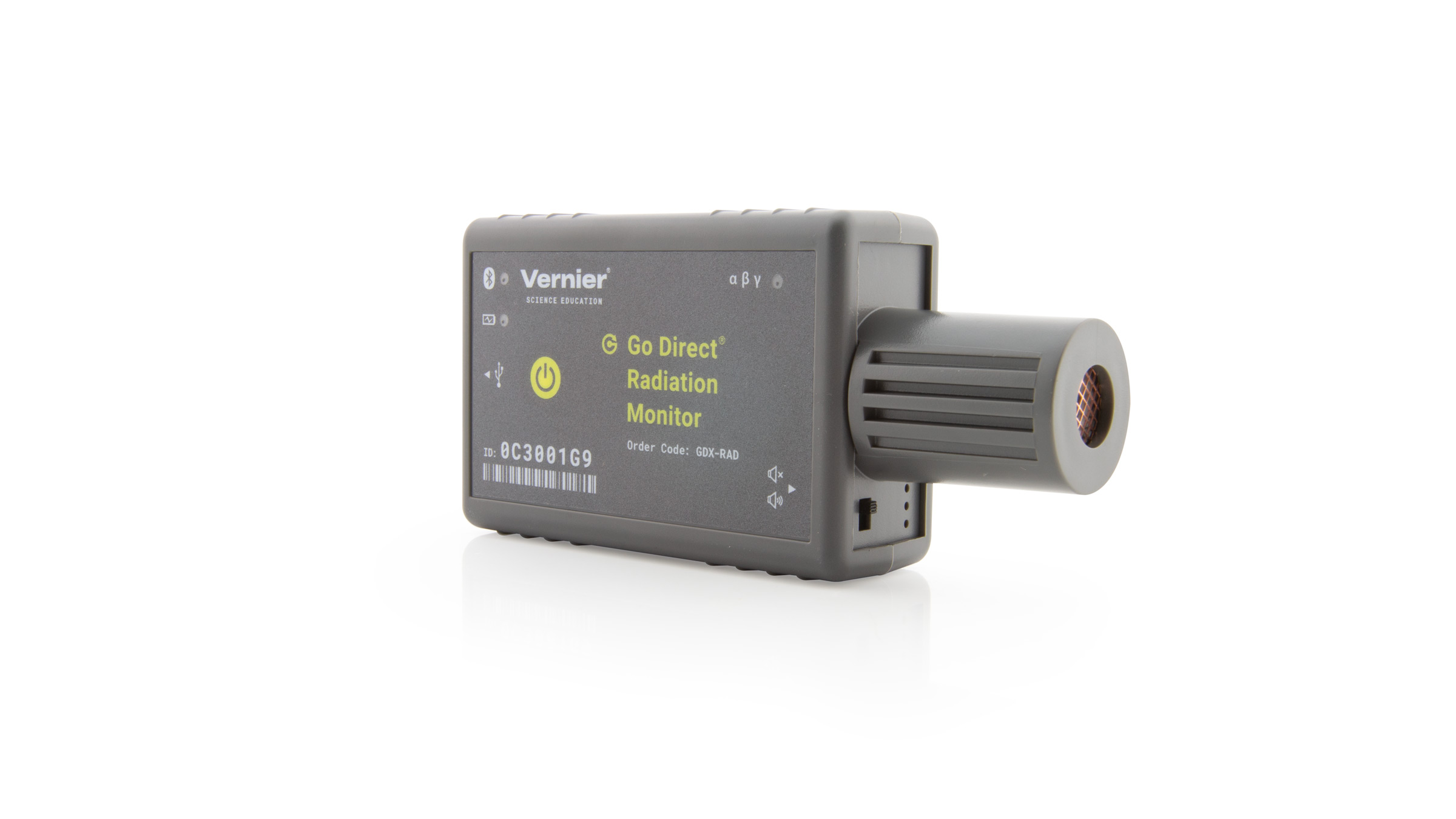Troubleshooting
General: Connect your sensor as described in the Getting Started instructions for your device. Verify that the Radiation Monitor is automatically identified.
- Primary Test: Place the Radiation Monitor near a radioactive source and collect data. Look at the LED, labeled αβγ, on the body of the Radiation Monitor – it will flash with each count; optionally turn on the audio signal to listen for counts. The total counts will accumulate in the data-collection software.
For free experiments using this sensor, see Nuclear Radiation with Vernier.
Usage Tips
- Tip 1: The Radiation Monitor measures total counts during the data-collection period, including any background radiation. A simple way to estimate the background radiation in your location is to run the Radiation Monitor without any radioactive source nearby for the same duration as your experimental trials. The total counts during that time interval will give you an idea of how much background radiation you can expect during each of your experimental trials.
- Tip 2: Alpha particles interact easily with other matter and may be intercepted by the air between the source and the Radiation Monitor. If you are using an alpha source, be sure to place the Radiation Monitor within 1/4″ of the source. Likewise, alpha particles (and low energy beta particles and gamma radiation) do not have the energy to penetrate the plastic body of the Radiation Monitor. Place your source close to the wire screen at the end of the tube for the best reading.
Additional Troubleshooting
- What are the similarities and differences between radiation monitors?
- How can you tell whether you have alpha, beta, or gamma radiation?
- Can I monitor the radioactivity of red Fiestaware with your Radiation Monitor?
- Where can I buy sources for nuclear radiation activities?
- Why do I get lower than expected counts with Go Direct Radiation Monitor (GDX-RAD)?
- What is the dead time of the radiation monitor?
Specifications
- Sensor
⚬ LND 712 (or equivalent) halogen-quenched GM tube with a mica end window
⚬ mica end thickness: 1.5 to 2.0 mg/cm²
⚬ Sensitive to alpha, beta, gamma, and X-ray radiation - Gamma sensitivity: 18 cps/mR/hr referenced to Co-60
- Temperature range: –20 to 50˚C
- Operating range: 0 to 3,500 CPS
- Shortest count interval: 20 milliseconds
- Count indicators (connection to software not required)
⚬ Red LED blinks on radiation detection
⚬ Optional audio signal on radiation detection - Connections:
⚬ Wireless: Bluetooth® v4.2 (wireless range 30 m unobstructed)
⚬ Wired: USB 2.0 full speed - Battery: 300 mA Li-Poly
⚬ Battery Life (single, full charge): ~24 hours continuous data collection
⚬ Battery Life (lifetime): 2 – 5 years (typical)
WARRANTY
The GDX-RAD has a 5 year overall warranty, with a 1 year warranty on the GM tube. The GM tube has a finite life span, and it is normal that it must be replaced after a few years (although some tubes last much longer).
⚬ Tubes that fail within a year of purchase will be replaced under warranty.
⚬ Tubes that fail after a year will be replaced for a fixed fee of $89.
⚬ Tubes that are punctured will not be replaced under warranty.
Calibration
Calibrate? No. This sensor cannot be calibrated.
Battery Troubleshooting
- If the sensor can be turned on when connected by USB but not when disconnected from USB, the battery either needs charging or has reached its end of life and can no longer hold a charge.
⚬ First, try charging the sensor for several hours. - If the sensor still won’t turn on when disconnected from USB, try swapping the battery with a working sensor to see if the problem follows the battery or stays with the sensor.
⚬ If the problem stays with the sensor, the battery is probably not the issue.
⚬ If the problem follows the battery, the battery has likely reached its end of life. - If you intend to use this sensor wirelessly, its battery will need replacing.
Go Direct® 300 mAh Replacement Battery (GDX-BAT-300 ) - See How do I remove or replace a Go Direct battery? for more information (including a video).
Rechargeable batteries are covered by a one-year warranty.
Batteries should last two to five years in typical use.
Related Products
- Micro USB to USB-C Cable (
CB-USB-C-MICRO ) - Go Direct® Charge Station (
GDX-CRG ) - Sensor Bracket for Go Direct® (
GDX-MOUNT ) - Vernier Radiation Monitor (
VRM-BTD )
Replacement Parts
- Go Direct® 300 mAh Replacement Battery (
GDX-BAT-300 ) - Micro USB Cable (
CB-USB-MICRO )

